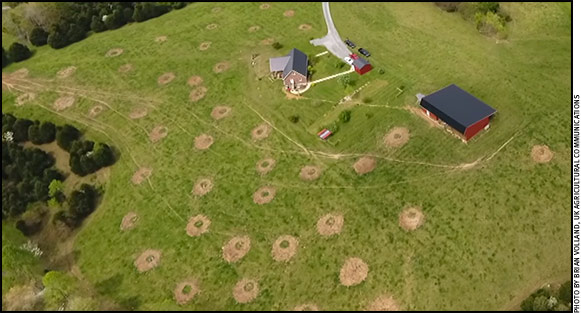MANAGEMENT...

Bale-grazing Progressing in Second Year
Farmer reduces fertilizer costs by bale-grazing his cattle.
When Adair County, Ky., farmer Fred Thomas started a bale-grazing demonstration project two years ago with the University of Kentucky (UK) College of Agriculture, Food and Environment, he was looking for a way to improve the health of his cattle and his pastures. As the project moves along, Thomas continues to be encouraged by the results.
“The cattle are happier, and I am happier,” Thomas said. “They did not have to stand in mud at all this year, and it was much easier to maintain their condition through the winter. It might be premature to say, but I have more grass growing this year than I have [had] since I bought the place in 2001.” Read more.
Irrigated Pasture Management
Expert says grazing hay fields can be more profitable than haying them.
With well-planned intensive management, irrigated pasture can often be more productive than the same ground used for haying. Some ranchers are looking at a change from haying to grazing irrigated fields.
Randy Wiedmeier, University of Missouri (MU) Extension livestock specialist, spent 25 years at Utah State University working with range and forage projects.
“We were trying to address some of the problems western ranchers face with public lands. We looked at ways they could extend private grazing as an alternative when they were unable to utilize their range permits or if numbers were cut,” he says. Read more.
Year-round Grazing Using Standing Corn for Winter Feed
Researchers prove raising cattle with little to no hay can be done in the West.
Research at Utah State University (USU) a few years ago looked into a year-round grazing system. Randy Wiedmeier, now a University of Missouri (MU) Extension livestock specialist, spent 25 years at USU working on range and forage projects. One project focused on using field corn to provide winter grazing after grazing irrigated pasture during the summer and fall.
“We started grazing silage-type corn in the winter and were very successful. For three years in a row we had a group of cows that never received any hay.”
This was a huge accomplishment because in Utah’s climate, cattle have to be fed for many months during winter. The corn stands above the snow, and Cache Valley gets a lot of snow. Read more.
When is the Best Time to Spread Manure?
MSU EnviroImpact is a new tool for Michigan livestock producers to use when deciding on manure applications.
When is the best time to spread manure for optimal crop production and minimize environmental losses? The simple answer is it depends on many factors. While not exactly a satisfying answer to a complex scenario, it truly depends on the manure-handling system, cropping system, field conditions, weather forecasts, time and labor available, volume of manure in the pit, and many more factors. What is the right decision when there are so many factors out of our control? The best answer is to know the risk factors during the time of manure application and minimize those risks while optimizing crop production with those additional manure nutrients. Read more.

Justin Sexten
Ranch environment and beef demand.
You’ve heard about it often enough: Match the cow to your environment. The articles and presentations say optimize the use of land, labor and forage resources; monitor success by measuring pounds of beef per acre.
That sounds simple enough, but individuals vary their interpretations. Those who love to put more labor into it may select for twinning and double their output. Of course, that’s far-fetched and rejected by any who have experienced the tradeoffs of trying to get twins born unassisted to a dam that will rouse them both to nurse and then raise them both to weaning. You certainly get rapid feedback as to success or failure, and that serves as part of your environment: The challenge of raising twins is greater than the increased production per acre. Read more.
Farm Income Declines While Farmland Values Rise
Income falls year over year.
While farm income continued to decline in the Midwest and Mid-South during the first quarter of 2017, values for quality farmland, ranchland or pastureland experienced the largest increases in three and a half years, according to the latest Agricultural Finance Monitor published by the Federal Reserve Bank of Saint Louis.
The survey was conducted from March 15 to March 31, 2017. The results were based on the responses of 32 agricultural banks located within the boundaries of the Eighth Federal Reserve District. The Eighth District comprises all or parts of the following seven Midwest and Mid-South states: Arkansas, Illinois, Indiana, Kentucky, Mississippi, Missouri and Tennessee. The survey included three special questions that focused on farm loan portfolios and bankers’ top concerns for 2017. Read more.
New Products
Industry affiliates provide a wide array of products and services to assist you on the farm and ranch. Here’s an assortment of new products to hit the market recently.
- Hearing protection
- Solar panel kit
- Entry-level hay and cattle tractor
- Kitchen confidence
- Engaging consumers
- Rumen resources
Angus Advisor
Click here for June herd management tips from cattle experts across the nation. Advice separated by region.
[Click here to go to the top of the page.]







